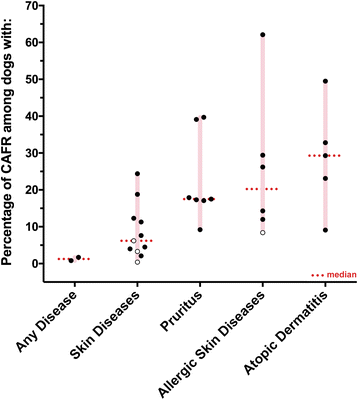Critically appraised topic on adverse food reactions of companion animals (3): prevalence of cutaneous adverse food reactions in dogs and cats
- PMID: 28202060
- PMCID: PMC5311844
- DOI: 10.1186/s12917-017-0973-z
Critically appraised topic on adverse food reactions of companion animals (3): prevalence of cutaneous adverse food reactions in dogs and cats
Abstract
Background: The prevalence of cutaneous adverse food reactions (CAFRs) in dogs and cats is not precisely known. This imprecision is likely due to the various populations that had been studied. Our objectives were to systematically review the literature to determine the prevalence of CAFRs among dogs and cats with pruritus and skin diseases.
Results: We searched two databases for pertinent references on August 18, 2016. Among 490 and 220 articles respectively found in the Web of Science (Science Citation Index Expanded) and CAB Abstract databases, we selected 22 and nine articles that reported data usable for CAFR prevalence determination in dogs and cats, respectively. The prevalence of CAFR in dogs and cats was found to vary depending upon the type of diagnoses made. Among dogs presented to their veterinarian for any diagnosis, the prevalence was 1 to 2% and among those with skin diseases, it ranged between 0 and 24%. The range of CAFR prevalence was similar in dogs with pruritus (9 to 40%), those with any type of allergic skin disease (8 to 62%) and in dogs diagnosed with atopic dermatitis (9 to 50%). In cats presented to a university hospital, the prevalence of CAFR was less than 1% (0.2%), while it was fairly homogeneous in cats with skin diseases (range: 3 to 6%), but higher in cats with pruritus (12 to 21%) than in cats with allergic skin disease (5 to 13%).
Conclusions: Among dogs and cats with pruritus and those suspected of allergic skin disease, the prevalence of CAFR is high enough to justify this syndrome to be ruled-out with a restriction (elimination)-provocation dietary trial. This must especially be considered in companion animals with nonseasonal pruritus or signs of allergic dermatitis.
Keywords: Allergy; Atopic Dermatitis; Canine; Cat; Dog; Feline; Food Allergy; Itch; Pruritus.
Figures


Similar articles
-
Critically appraised topic on adverse food reactions of companion animals (7): signalment and cutaneous manifestations of dogs and cats with adverse food reactions.BMC Vet Res. 2019 May 9;15(1):140. doi: 10.1186/s12917-019-1880-2. BMC Vet Res. 2019. PMID: 31072328 Free PMC article. Review.
-
Critically appraised topic on adverse food reactions of companion animals (1): duration of elimination diets.BMC Vet Res. 2015 Aug 28;11:225. doi: 10.1186/s12917-015-0541-3. BMC Vet Res. 2015. PMID: 26310322 Free PMC article.
-
Critically appraised topic on adverse food reactions of companion animals (9): time to flare of cutaneous signs after a dietary challenge in dogs and cats with food allergies.BMC Vet Res. 2020 May 24;16(1):158. doi: 10.1186/s12917-020-02379-3. BMC Vet Res. 2020. PMID: 32448251 Free PMC article. Review.
-
Serum IgE and IgG responses to dietary antigens in dogs with and without cutaneous adverse food reactions.Vet Dermatol. 2020 Apr;31(2):116-127. doi: 10.1111/vde.12810. Epub 2019 Nov 20. Vet Dermatol. 2020. PMID: 31749195
-
Critically appraised topic on adverse food reactions of companion animals (2): common food allergen sources in dogs and cats.BMC Vet Res. 2016 Jan 12;12:9. doi: 10.1186/s12917-016-0633-8. BMC Vet Res. 2016. PMID: 26753610 Free PMC article.
Cited by
-
Analysis of Intestinal Microbiota and Metabolic Pathways before and after a 2-Month-Long Hydrolyzed Fish and Rice Starch Hypoallergenic Diet Trial in Pruritic Dogs.Vet Sci. 2023 Jul 21;10(7):478. doi: 10.3390/vetsci10070478. Vet Sci. 2023. PMID: 37505882 Free PMC article.
-
Cross-contamination in canine and feline dietetic limited-antigen wet diets.BMC Vet Res. 2018 Sep 12;14(1):283. doi: 10.1186/s12917-018-1571-4. BMC Vet Res. 2018. PMID: 30208880 Free PMC article.
-
Assessment of dog owners' knowledge relating to the diagnosis and treatment of canine food allergies.Can Vet J. 2019 Mar;60(3):268-274. Can Vet J. 2019. PMID: 30872849 Free PMC article.
-
Critically appraised topic on adverse food reactions of companion animals (7): signalment and cutaneous manifestations of dogs and cats with adverse food reactions.BMC Vet Res. 2019 May 9;15(1):140. doi: 10.1186/s12917-019-1880-2. BMC Vet Res. 2019. PMID: 31072328 Free PMC article. Review.
-
Evaluation of the theoretical risk of cross-reactivity among recently identified food allergens for dogs.Vet Dermatol. 2022 Dec;33(6):523-526. doi: 10.1111/vde.13110. Epub 2022 Aug 31. Vet Dermatol. 2022. PMID: 36043337 Free PMC article.
References
-
- Kunkle G, Horner S. Validity of skin testing for diagnosis of food allergy in dogs. J Am Vet Med Assoc. 1992;200:677–80. - PubMed
-
- Denis S, Paradis M. L’allergie alimentaire chez le chien et le chat. 2. Etude rétrospective (food allergy in dogs and cats. 2. retrospective study) Méd Vét Québec. 1994;24:15–20.
-
- Vroom MW. A retrospective study of 45 west-highland-white terriers with skin problems. Tijdschr Diergeneeskd. 1995;120:292–5. - PubMed
-
- Guilford WG, Markwell PJ, Jones BR, Harte JG, Wills JM. Prevalence and causes of food sensitivity in cats with chronic pruritus, vomiting or diarrhea. J Nutr. 1998;128:2790S–1S. - PubMed
Publication types
MeSH terms
LinkOut - more resources
Full Text Sources
Other Literature Sources
Medical
Research Materials
Miscellaneous

